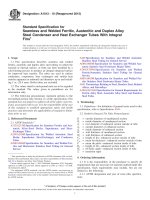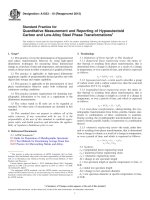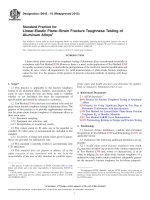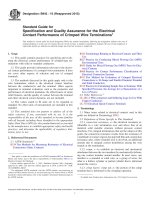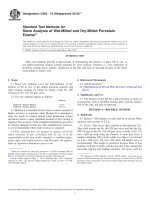Astm e 1868 10 (2015)
Bạn đang xem bản rút gọn của tài liệu. Xem và tải ngay bản đầy đủ của tài liệu tại đây (118.05 KB, 6 trang )
Designation: E1868 − 10 (Reapproved 2015)
Standard Test Methods for
Loss-On-Drying by Thermogravimetry1
This standard is issued under the fixed designation E1868; the number immediately following the designation indicates the year of
original adoption or, in the case of revision, the year of last revision. A number in parentheses indicates the year of last reapproval. A
superscript epsilon (´) indicates an editorial change since the last revision or reapproval.
(Moisture) Content of Soil and Rock by Mass
D2288 Test Method for Weight Loss of Plasticizers on
Heating (Withdrawn 2010)3
D2595 Test Method for Evaporation Loss of Lubricating
Greases Over Wide-Temperature Range
D2832 Guide for Determining Volatile and Nonvolatile Content of Paint and Related Coatings
D3175 Test Method for Volatile Matter in the Analysis
Sample of Coal and Coke
D4017 Test Method for Water in Paints and Paint Materials
by Karl Fischer Method
D4893 Test Method for Determination of Pitch Volatility
E177 Practice for Use of the Terms Precision and Bias in
ASTM Test Methods
E359 Test Methods for Analysis of Soda Ash (Sodium
Carbonate)
E473 Terminology Relating to Thermal Analysis and Rheology
E691 Practice for Conducting an Interlaboratory Study to
Determine the Precision of a Test Method
E897 Test Method for Volatile Matter in the Analysis Sample
of Refuse-Derived Fuel (Withdrawn 2011)3
E1142 Terminology Relating to Thermophysical Properties
E1582 Practice for Calibration of Temperature Scale for
Thermogravimetry
E1860 Test Method for Elapsed Time Calibration of Thermal Analyzers
E2040 Test Method for Mass Scale Calibration of Thermogravimetric Analyzers
2.2 SCAQMD Documents:4
Rule 1144 Metalworking Fluids and Direct-Contact Lubricants
1. Scope
1.1 These test methods describe a procedure for determining
the amount of volatile matter of any kind that is driven off from
a test specimen under a specific set of temperature and time
conditions. These test methods determine only the mass of
material lost, not its identity.
1.2 These test methods are applicable to a wide variety of
solid or liquid materials, mixtures, or blends where the major
component is stable at the test temperature.
NOTE 1—These test methods can be applied to the analysis of volatile
organic compounds (VOC) content in metalworking fluids and direct
contact lubricants subject to South Coast Air Quality Management District
(SCAQMD) Rule 1144.
1.3 The applicable temperature range for these test methods
are generally between ambient temperature and 1000°C.
1.4 The values stated in SI units are to be regarded as
standard. No other units of measurement are included in this
standard.
1.5 There is no ISO method equivalent to this test standard.
1.6 This standard does not purport to address all of the
safety concerns, if any, associated with its use. It is the
responsibility of the user of this standard to establish appropriate safety and health practices and determine the applicability of regulatory limitations prior to use.
2. Referenced Documents
2.1 ASTM Standards:2
D6 Test Method for Loss on Heating of Oil and Asphaltic
Compounds
D1475 Test Method For Density of Liquid Coatings, Inks,
and Related Products
D1509 Test Methods for Carbon Black—Heating Loss
D2216 Test Methods for Laboratory Determination of Water
3. Terminology
3.1 Definitions:
3.1.1 Specific technical terms used in this test method are
defined in Terminology E473 and Terminology E1142, including thermogravimetry, thermogravimetric analyzer,
repeatability, and reproducibility.
1
These test methods are under the jurisdiction of ASTM Committee E37 on
Thermal Measurements and is the direct responsibility of Subcommittee E37.01 on
Calorimetry and Mass Loss.
Current edition approved May 1, 2015. Published May 2015. Originally
approved in 1997. Last previous edition approved in 2010 as E1868 – 10. DOI:
10.1520/E1868-10R15.
2
For referenced ASTM standards, visit the ASTM website, www.astm.org, or
contact ASTM Customer service at For Annual Book of ASTM
Standards volume information, refer to the standard’s Document Summary page on
the ASTM website.
3
The last approved version of this historical standard is referenced on
www.astm.org.
4
Available from South Coast Air Quality Management District (SCAQMD),
21865 Copley Drive, Diamond Bar, CA, 91765, .
Copyright © ASTM International, 100 Barr Harbor Drive, PO Box C700, West Conshohocken, PA 19428-2959. United States
1
E1868 − 10 (2015)
4. Summary of Test Method
7. Apparatus
4.1 A specimen of known mass is heated at a constant
temperature while its mass is continuously measured as a
function of time. At the end of a pre-determined time interval,
or when the loss reaches a pre-determined rate, the mass loss of
the specimen is recorded as a percent of the original mass. This
value is identified as the loss-on-drying (LOD) value. The
LOD value is a function of both temperature and time.
Therefore these values must be identified and reported. A
typical LOD value is reported as LOD = XX % (60 min at
120°C). The volatile content, V (g/L), or VOC content, VOC
(g/L), may be calculated.
7.1 Thermogravimetric Analyzer, capable of continuously
recording specimen mass and temperature as a function of time
consisting of:
7.1.1 Electrobalance, with a minimum specimen capacity of
100 mg capable of continuously recording 10 µg or smaller
mass changes. Performance may be verified in accordance with
Test Method E2040.
7.1.2 Specimen Holders, that are inert to the specimen and
of suitable structural shape and integrity to contain the 10 mg
test specimen used in these test methods. Specimen holders,
composed of platinum, aluminum, or quartz may be used, but
other holders may be considered.
NOTE 2—For SCAQMD Rule 1144 purposes, at the end of a predetermined time interval and specified temperature, the mass loss of the
specimen is recorded as a percent of the original mass. Additionally, the
density and water content of the sample are determined. These values are
then used to calculate the VOC content.
NOTE 3—For SCAQMD Rule 1144 purposes, specimen holders must be
shallow and composed of platinum.
7.1.3 Furnace, whose temperature can be controlled from
25 to 1000°C, capable of a heating rate, at a minimum, of
5°C/min and of maintaining a set temperature isothermally
within that range to 62°C.
7.1.4 Temperature Sensor to provide an indication of the
specimen or furnace temperature, or both, to 60.1°C.
5. Significance and Use
5.1 These test methods are used to estimate the amount of
volatile materials present in a material.
5.2 These test methods are useful for design purposes,
service evaluation, regulatory statutes, manufacturing control,
quality control, specification acceptance, development, and
research.
NOTE 4—The temperature sensor shall be placed as close as practical to
the test specimen without disturbing weight measurements or as specified
by the manufacturer. In addition, it must be located in exactly the same
position during analytical determinations as used during calibration.
7.1.5 Specimen Atmosphere Control System, capable of
supplying inert dry gas (usually purified grade nitrogen) with
an operator selectable flow rate of 50 to 100 mL ⁄min to within
65 mL ⁄min.
5.3 The results obtained by these test methods may be
equivalent to those obtained by other test methods and may be
known by other terms in their respective fields. Other tests and
terms encountered include loss-on-heating (see Footnote 5 and
Test Methods D6, D2288, and E359); heating loss (see Test
Method D1509); evaporative loss (see Test Method D2595);
volatile organic carbon, moisture, or water (see Test Methods
D2216 and D3175); volatility (see Test Method D4893); highly
volatile matter (see Test Method E897); and volatile content
(see Guide D2832).
NOTE 5—For SCAQMD Rule 1144 purposes, use purified grade nitrogen for both the sample purge flow and balance protection flow.
7.1.6 Measurement System, to continuously record specimen temperature to within 60.1°C over the range from 25 to
1000°C.
7.1.7 Timer, capable of continuously recording elapsed time
up to 20 h to within 6 0.1 min or 61 %, whichever is greater.
Performance may be verified in accordance with Test Method
E1860.
7.1.8 Controller, capable of executing a temperature program by operating the furnace from 25 to 1000°C at a
minimum rate of 5°C/min to within 60.1°C/min and of
maintaining a set temperature isothermally within the range of
62°C.
7.1.9 Data Collection Device, provide a means of acquiring,
storing, and displaying measured or calculated signals, or both.
The minimum output signals required for thermogravimetric
analysis (TGA) are mass, temperature, and time.
7.1.10 While not required, it is convenient to have a data
analysis device that will continuously perform and display the
following calculation:
7.1.10.1 Specimen mass as a percent of the initial mass.
7.1.10.2 Specimen mass rate of change (in mass % ⁄min)
capable of detecting 0.01 % ⁄min.
7.1.11 While not required, it is convenient to have an
experiment control device capable of terminating the experiment under the following conditions:
6. Interferences
6.1 Because the specimen size is usually small, care must be
taken to ensure that each specimen is representative of the
sample as a whole.
6.2 This test procedure measures total mass loss under
specific experimental conditions. If more than one volatile
component is present, the results will reflect the total of all
those volatile components present.
6.3 If the test temperature is set too high, the resultant
weight loss may include some decomposition of the matrix
material.
6.4 When calculating VOC content for SCAQMD
Rule 1144 purposes, it may be necessary to measure and
correct for water content. Refer to Test Method D4017 to
determine the water content of the specimen.
5
Formulary Vol XVII is available from U.S. Pharmacopeia (USP), 12601
Twinbrook Pkwy., Rockville, MD 20852-1790, .
2
E1868 − 10 (2015)
7.1.11.1 When an operator selected period of time at an
isothermal temperature condition has elapsed, and
7.1.11.2 When an operator selected rate of mass loss is
achieved.
11.1 Obtain a suitable baseline correction.
11.2 Set the furnace and flow parameters.
NOTE 10—For SCAQMD Rule 1144 purposes, the total flow must be
50 mL ⁄ min, divided (balance protection flow:sample purge flow) either
10:40 mL/min or 20:30 mL/min.
7.2 Gas Exhaust System capable of removing from the
laboratory the potentially noxious purge gas effluent of the
system above.
11.3 Cool the specimen test area of the apparatus to ambient
temperature. For the purpose of this test, ambient temperature
is 35°C or lower.
7.3 Inert Gas—Purified grade nitrogen.
7.4 Micropipettes or Syringes, for liquids, capable of dispensing up to 15 6 1 µL.
NOTE 11—Cooling of the specimen test area to 25°C following an
experiment is time consuming on some apparatus. To improve
productivity, it is possible with some test samples to initiate the experiment at a somewhat higher temperature. This must be done with caution
since volatility is a function of temperature. For highly volatile materials,
appreciable portions of the test specimen mass may be lost in experimental
set up, if initiated at too high of a temperature.
NOTE 12—For SCAQMD Rule 1144 purposes, initial temperature is
25 6 2°C.
8. Hazards
8.1 Toxic or corrosive effluent, or both, may be released
when heating some materials and could be harmful to personnel and to apparatus.
9. Sampling
11.4 With the apparatus closed in the normal operating
position, tare the balance so that the empty sample pan
indicates zero mass.
9.1 Samples are usually analyzed on “as received” basis.
Should some thermal or mechanical treatment (such as grinding or sieving) be applied to the sample prior to analysis, it
shall be indicated in the report. Grinding may release volatiles
due to the heating generated by grinding process.
11.5 Open the apparatus to expose the specimen holder.
11.6 Carefully place 10 6 1 mg of the test specimen on the
specimen holder. Other specimen sizes may be used but must
be indicated in the report.
9.2 Since small test specimens are used, they must be
homogeneous and representative of the sample. The mixing or
stirring of samples prior to analysis is recommended whenever
possible.
NOTE 13—Care should be taken to ensure that the sample is free of air
bubbles.
NOTE 14—For SCAQMD Rule 1144 purposes, specimen size is
10 6 1 µL, autosamplers are not to be used and the specimen must be
distributed evenly over the bottom of the specimen holder.
9.3 If experiments are to be initiated at room temperature,
equilibrate samples in their sealed containers to room temperature prior to testing.
11.7 Close the apparatus and record the initial mass as mi. If
the apparatus has provisions for direct recording of mass
percent, adjust it to read 100 %.
NOTE 6—For SCAQMD Rule 1144 purposes, samples containing solid
particles should be filtered prior to analysis.
NOTE 15—Should the test specimen have appreciable volatility at
ambient temperature, it may lose a significant amount of mass as it is
placed into the test position. In such cases, care should be taken to perform
11.6 and 11.7 as quickly as is practical.
10. Calibration
10.1 Calibrate the temperature signal from the apparatus
according to Practice E1582 using a heating rate of 1°C/min
and a transition temperature close to the isothermal test
temperature used in this procedure.
11.8 Heat the test specimen at 5°C/min to the isothermal test
temperature, while recording specimen mass (or mass percent),
temperature and elapsed time. Other heating rates may be used,
but must be indicated in the report.
10.2 Calibrate the mass signal from the apparatus according
to Test Method E2040.
NOTE 16—Selection of the optimum operating parameters of isothermal
test temperature and test time (tt) is dependent on the class of materials
being tested. The technique of response surface methodology (RSM) may
be useful in predicting optimum operating parameters.7,8 Some common
experimental conditions are presented in Tables 1 and 2.
NOTE 17—For SCAQMD Rule 1144 purposes, heating rate is 25°C/min
and isothermal test temperature is 81°C.
NOTE 7—Regular analysis of performance standards (materials of
known mass loss characteristics) where available,6 serves as a check on
instrument status, operator efficiency, etc., and provides for a comparison
of results from different laboratories. Verify mass measurement conformity to better than 1 %. Verify time measurement conformity to better
than 1 %.
10.3 Calibrate the time signal from the apparatus according
to Test Method E1860.
11.9 Once the isothermal test temperature is reached, it is
held there for the remainder of the experiment. The time from
start to the isothermal portion of the experiment is taken as ti.
NOTE 8—For SCAQMD Rule 1144 purposes, calibrate the mass signal
every week, the temperature signal every three months, and the time signal
every six months.
11.10 After 5 min at the isothermal test temperature, the
specimen temperature may be recorded.
11. Procedure
NOTE 9—For SCAQMD Rule 1144 purposes, additional proceedures
may be required by the agency.
7
Box, G.E.P., and Hunter, J.S., “Multi Factor Experimental Designs for
Exploring Response Surfaces,” Annals of Mathematical Statistics, Vol 28, 1997, pp.
195–241.
8
Pino, J.A., Barry, T.A., and Rose, J.E., “Estimation of Volatile Emission
Potential of Pesticides by Thermogravimetric Analysis,” Proceedings 110th American Offıcial Analytical Chemists Meeting, 1996.
6
Performance Standards for low (2 %), medium (50 %), and high (99 %) LOD
values are available from several suppliers. Contact ASTM International for list of
suppliers.
3
E1868 − 10 (2015)
TABLE 1 Commonly Used Isothermal Test Temperatures and
Times
Material
Grease
Barium Hydroxide
Barium Sulfate
Calcium Carbonate
Lubricants
Temperature, °C
93
105
105
200
81
Pesticides
Refuse Derived Fuel
Pitch
Soil and Rock
Polymers
Carbon Black
Soda Ash
Asphalt
65
950
360
110
155
125
250
163
Time, h
20
2
4
4
1.83
(110 m.
from start)
11
0.1
0.5
12
24
1
4
5
11.16 Perform duplicate determinations and report the losson-drying value as the mean value of duplicate determinations
of percent mass loss.
Test Method
D2595
A
NOTE 22—For SCAQMD Rule 1144 purposes, perform duplicate determinations. Unless SCAQMD quality control procedures fail, calculate
and report VOC content according to Eq 3 (see 12.3) as the mean value of
duplicate determinations.
A
A
E1868
12. Calculation
E1868
E897
D4893
D2216
D2288
D1509
E359
D6
12.1 Loss-on-Drying:
12.1.1 Calculate percent mass loss according to the following equation:
m5
~ m i 2 m f ! 3 100 %
mi
A
Formulary Vol XVII, United States Pharmacopoeia Convention, 12601 Twinbrook
Parkway, Rockville, MD 20852.
LOD 5 mean value of m for duplicate determinations
where:
LOD =
m
=
=
mi
=
mf
TABLE 2 Commonly Used Rates of Loss and Delay Times
Material
Pesticides
Rate of Loss,
%/min
0.1
Delay Time,
min
15
(1)
Reference
no
2.2A
A
Pino, J., Barry, T., and Rose, J., Estimation of Volatile Emission of Pesticides by
Thermogravimetric Analysis, California Environmental Protection Agency, 1020 N
Street, Room 161, Sacramento, CA 95814-5624.
loss-on-drying (%),
percent mass loss (%),
initial mass (mg), and
final mass (mg).
12.2 Volatile Material Content:
12.2.1 Calculate the amount of volatile material, V, in grams
per litre from a liquid sample, according to the following
equation:
11.11 The experiment is terminated in one of two ways.
These termination criteria are identified as Test Method A and
Test Method B.
v5
F~
G
m i 2 m f!
3 ρ 3 1000 mL/L
mi
(2)
where V, the volatile content in g/L, is the mean value of v
for replicate determinations, where the number of determinations may be one, and where:
11.12 Test Method A:
11.12.1 After the test specimen is held at the isothermal test
temperature for a fixed period of test time (tt).
v
ρ
mi
mf
NOTE 18—Commonly used isothermal test temperatures and times are
tabulated in Table 1.
NOTE 19—For SCAQMD Rule 1144 purposes, test time (tt) is 110
minutes. Test time is measured from the start of the heating cycle to the
end of the isothermal test time.
=
=
=
=
volatile content of a single measurement (g/L),
density of liquid sample (g/mL),
initial mass (mg), and
final mass (mg).
12.3 Volatile Organic Compounds (VOC) Content:
12.3.1 Calculate the volatile organic compounds content,
VOC content, in grams per litre from a liquid sample according
to the following equation:
11.12.1.1 Experiments terminated using Test Method A
shall indicate the termination conditions in parentheses following the LOD values. For example: LOD = XX % (2 h at
105°C).
voc 5
11.13 Test Method B:
11.13.1 After a delay time (td) initiated when the mass loss
rate becomes less than a specified value (R).
HF ~
G
J
w
m i 2 m f!
2
3 ρ 3 1000 mL/L
mi
100 %
(3)
where VOC, the volatile organic compounds content in g/L,
is the mean value of voc for replicate determinations, where the
number of determinations may be one, and where:
NOTE 20—Commonly used values for mass loss rate and delay time are
tabulated in Table 2.
NOTE 21—For apparatus so equipped, the mass loss rate may be
conveniently observed using the derivative of mass as a function of time.
voc = volatile organic compounds content of a single measurement (g/L),
ρ
= density of liquid sample (g/mL),
w
= water content (%),
mi = initial mass (mg), and
mf = final mass (mg).
11.13.1.1 Experiments terminated using Test Method B
shall indicate the termination conditions in parentheses following the LOD values. For example: LOD = XX % (15 min at
<1 % ⁄min).
NOTE 23—For SCAQMD Rule 1144 purposes, use Test Method D1475
for the determination of density and Test Method D4017 for the determination of the water content of the sample.
NOTE 24—Measured values should be entered into the equation
retaining all decimal places. Only the final report value should be rounded
in accordance with the established precision of the test.
11.14 Record the mass at the time of the termination of the
experiment. This value is the final mass, mf.
11.15 Calculate the percent mass loss value according to Eq
1 (see 12.1).
4
E1868 − 10 (2015)
TABLE 3 Volatile Compounds (g/L)
13. Report
13.1 Report the following information:
13.1.1 A complete identification and description of the
material being tested,
13.1.2 A description of the instrument used to perform the
test including manufacturer and model number,
13.1.3 A description of the temperature calibration material
and procedure used,
13.1.4 The thermal curves for the determination via the
method, and
13.1.5 The LOD value as well as the experiment termination conditions (see 11.12.1.1 and 11.13.1.1). For example:
5.0 % (2 h at 105°C). V or VOC values may also be reported
as necessary.
A
Sample Average
¯
X
D
F
G
H
A
633
59.0
970.1
89.2
Repeatability
Standard
Deviation
Sr
12
3.6
3.6
5.1
Reproducibility
Standard
Repeatability Reproducibility
Deviation
Limit
Limit
SR
r
R
16
32
44
11
9.9
32
21
10
59
11
14
30
The average of the laboratories’ calculated averages.
(1) Reproducibility limits are listed in Table 3 below. The
reproducibility value estimates the 95 % confidence limit.
14.1.2.3 The above terms (repeatability limit and reproducibility limit) are used as specified in Practice E177.
14.1.2.4 Any judgment in accordance with statements
14.1.2.1 and 14.1.2.2 would have an approximate 95 % probability of being correct.
14.1.3 Bias—At the time of the study, there was no accepted
reference material suitable for determining the bias for this test
method, therefore no statement on bias is being made.
14.1.4 The precision statement was determined through
statistical examination of 155 results, from 8 laboratories, on a
total of 4 different sample materials. These materials were
described as:
NOTE 25—For SCAQMD Rule 1144 purposes, report VOC.
13.2 The specific dated version of this method used.
NOTE 26—For SCAQMD Rule 1144 purposes, consult with the agency
for any other specific reporting requirements.
14. Precision and Bias9
14.1 Test Method A:
14.1.1 An interlaboratory study (ILS) was conducted for
Test Method A in 2009–2010 on behalf of the SCAQMD
(ILS 500).4 Eight laboratories participated in this study. Each
of the labs was asked to report five replicate test results for four
different liquid lubricant sample materials. Samples D, F, and
H were analyzed by all eight laboratories. Sample G was
analyzed by seven laboratories. Every “test result” reported
represented a single determination or measurement; data is
expressed as volatile organic compounds in grams per litre.
Practice E691 was followed for the design and analysis of the
data; the details are given in ASTM Research Report RR:E371039.10 See the research report for additional method parameters specific to these lubricant samples.
14.1.2 Precision:
14.1.2.1 Repeatability Limit (r)—Two test results obtained
within one laboratory shall be judged not equivalent if they
differ by more than the “r” value for that material; “r” is the
interval representing the critical difference between two test
results for the same material, obtained by the same operator
using the same equipment on the same day in the same
laboratory.
(1) Repeatability limits are listed in Table 3 below. The
repeatability value estimates the 95 % confidence limit.
14.1.2.2 Reproducibility Limit (R)—Two test results shall be
judged not equivalent if they differ by more than the “R” value
for that material; “R” is the interval representing the critical
difference between two test results for the same material,
obtained by different operators using different equipment in
different laboratories.
D
Rust preventive, formulated from a combination of
proprietary rust preventive, 80 % Stoddard Solvent
(flash point, 40°C) and 10 % napthenic mineral oil
(viscosity, approximately 1.3 cSt.), density,
0.7873 g ⁄ mL
F
Oil-based cutting fluid (general purpose), formulated
from a proprietary combination of lubricity agents and
70 % napthenic mineral oil (viscosity, approximately
32.3 cSt.), density, 0.9439 g ⁄ mL
G
Proprietary water-diluted semisynthetic cutting fluid,
93 % water, density, 1.0084 g ⁄ mL
H
Oil-based cutting fluid (aluminum), formulated from a
combination of lubricity agents and 70 % napthenic
mineral oil (viscosity approximately 6.9 cSt.), density,
0.8852 g ⁄ mL
To judge the equivalency of two test results, it is recommended to choose a sample material closest in characteristics
to the test material.
14.2 Test Method B:
14.2.1 An ILS was conducted for Test Method B in
1995–1996 by the California Environmental Protection
Agency. The ILS involved participation by 15 laboratories
using 3 performance standards, 3 liquid and 2 solid end-use
materials (that is, pesticides). The performance standards were
synthetic materials made up to contain low, medium and high
levels of volatile corresponding to 2, 50, and 99 % mass loss.
14.2.2 Precision:
14.2.2.1 Within laboratory variability may be described
using the repeatability value (r), obtained by multiplying the
standard deviation by 2.8. The repeatability value estimates the
95 % confidence limit.
14.2.2.2 Repeatability values of r = 0.6, 0.4, and 0.5 % mass
loss were obtained on the low, medium and high loss performance standards, respectively.
9
Supporting data have been filed at ASTM International Headquarters and may
be obtained by requesting Research Report RR:E37-1020. Contact ASTM Customer
Service at
10
Supporting data have been filed at ASTM International Headquarters and may
be obtained by requesting Research Report RR:E37-1039. Contact ASTM Customer
Service at
5
E1868 − 10 (2015)
14.2.2.3 Repeatability values of r = 4.2, 1.8, and 0.6 % mass
loss were obtained on the three liquid end-use materials.
14.2.2.4 Repeatability values of r = 6.2 and 1.4 % mass loss
were obtained on the two solid end-use materials.
14.2.2.5 Between laboratory variability may be described
using the reproducibility value (R) obtained by multiplying the
standard deviation by 2.8. The reproducibility value estimates
the 95 % confidence limit.
14.2.2.6 Reproducibility values of R = 4.4, 1.0, and 0.3 %
mass loss were obtained on the low, medium, and high loss
performance standards, respectively.
14.2.2.7 Reproducibility values of R = 4.9, 2.2, and 0.7 %
mass loss were obtained on the three liquid end-use materials.
14.2.2.8 Reproducibility values of R = 6.6 and 2.0 % mass
loss were obtained on the two solid end-use materials.
14.2.3 Bias:
14.2.3.1 An estimation of bias is obtained by comparing the
mean mass loss values obtained for each performance standard
to their synthesize values. That is:
bias 5 ~ mean mass loss! 2 ~ known values!
(4)
(1) The bias was found to be less than 0.6 % mass loss for
all three levels of the performance standards. This indicates an
absence of significant relative bias.
15. Keywords
15.1 loss on drying; mass loss; thermogravimetry; thermogravimetric analysis; volatiles; weight loss
ASTM International takes no position respecting the validity of any patent rights asserted in connection with any item mentioned
in this standard. Users of this standard are expressly advised that determination of the validity of any such patent rights, and the risk
of infringement of such rights, are entirely their own responsibility.
This standard is subject to revision at any time by the responsible technical committee and must be reviewed every five years and
if not revised, either reapproved or withdrawn. Your comments are invited either for revision of this standard or for additional standards
and should be addressed to ASTM International Headquarters. Your comments will receive careful consideration at a meeting of the
responsible technical committee, which you may attend. If you feel that your comments have not received a fair hearing you should
make your views known to the ASTM Committee on Standards, at the address shown below.
This standard is copyrighted by ASTM International, 100 Barr Harbor Drive, PO Box C700, West Conshohocken, PA 19428-2959,
United States. Individual reprints (single or multiple copies) of this standard may be obtained by contacting ASTM at the above
address or at 610-832-9585 (phone), 610-832-9555 (fax), or (e-mail); or through the ASTM website
(www.astm.org). Permission rights to photocopy the standard may also be secured from the Copyright Clearance Center, 222
Rosewood Drive, Danvers, MA 01923, Tel: (978) 646-2600; />
6
